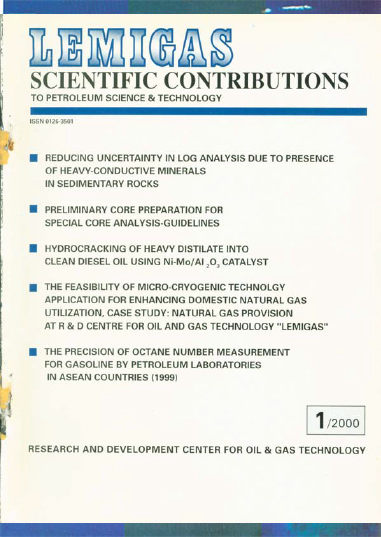Reducing Uncertainty In Log Analysis Due To Presence Of Heavy-Conductive Minerals In Sendimentary Rocks
DOI:
https://doi.org/10.29017/SCOG.23.1.880Keywords:
Mineral, Sendimentary RockAbstract
Presence of heavy-conductive mineral(s) in formation rocks tends to provide negative influence to some log readings especially the resistivity log. With regard to its function in log analysis, any distortion in resistivity log readings will certainly lead to potential misinterpretation on petrophysical properties such as water saturation (S.) Therefore a method dedicated to minimizing the effect is indeed necessary.
This paper presents results of a study on presence of heavy-conductive minerals, distributed in structural form, on resistivity reading. Based on analogy and expansion of a structural clay distribution model, a correction method plus its application procedure have been proposed. Since the method is develop using an approach that is considered valid in general term it is, therefore, conceptually applicable to any field cases as long as its theoretical conditions are met. In order to make application of the method easier it has also been presented in form of nomographs.
Application of the method on log analysis of two wells in West Java has proved itself well in which corrections on calculated water saturation have yielded values that are more consistent when compared to production test data. The method is also prepared in a manner that it can be easily integrated into standard log analysis practices.
References
Clavier, C., Heim, A. and Scala, C., 1976, "Effecet on Pyrite on Resistivity and Other Logging Measurements", SPWLA 17ð‘¡â„Ž Annual Logging Symposium. June 9 - 12.
Crane, S.D., 1990, "Impacts of Microporosity, Rough Pore Surfaces, and Conductive Minerals on Saturation Calculations from Electric Measurements: An Extended Archie's "Law, SPWLA Annual Logging Symposium, June 24-27.
Patnode, H.W. and Wyllie, M.R.J.,1950, "The Presence of Conductive Solids in Reservoir Rocks as a Factor in Electric Log Interpretation". Pet. Trans AIME, 189.
Sclumberger, 1989, Log Interpretation Principles/ Applications, Schlumberger Educational Services, 5000 Gulf Freeway. Houston-Texas 77023.
Schon, J.H., 1996, Physical Properties of Rocks: Fundamentall and Principles of Petrophysics. Handbook of Geophysiveal Exploration Seismic Exploration, Vol. 18 eds: Helbig, K and Treitel, S, Elsevier Science Ltd., Oxford OXS IGB-UK, p: 583.
Serra, O.,1986, Fundamentals of Well-log Interpretation, Part 2: The Interpretation of Logging Data. Elsevier Science Publisher B.V., Amsterdam, p: 683,
Waxman, M.H. and Smits, L.J.M., 1968, "Electrical Condu ctivities in Oil-bearing Shally-sands". Soc. of Pet. Eng. Journal.
Widarsono, B., Tanuwidjaja, K., Tjiptorahardjo, W., Hendarin, I, Arjono, and Susilo, R.H., 1997, "Reservoir Characterization in Non-carbonate Clastic Formation Containing Heavy Minerals (in Bahasa Indonesia)". Report for 1996/1997 PERTAMINA- LEMIGAS Research Program (unpublished).
Widarsono, B., 1999, "Correction Method in Log Analysis for Presence of Conductive Mineral (in Bahasa Indonesia)". Submitted for Patent at Directorate General for Intellectual Property Rights in the Department of Justice- Republic of Indonesia. Reg. No. P990466.
Downloads
Issue
Section
License
Copyright (c) 1970 SCIENTIFIC CONTRIBUTIONS OIL AND GAS (SCOG)

This work is licensed under a Creative Commons Attribution 4.0 International License.
Authors are free to Share — copy and redistribute the material in any medium or format for any purpose, even commercially Adapt — remix, transform, and build upon the material for any purpose, even commercially.
The licensor cannot revoke these freedoms as long as you follow the license terms, under the following terms Attribution — You must give appropriate credit , provide a link to the license, and indicate if changes were made . You may do so in any reasonable manner, but not in any way that suggests the licensor endorses you or your use.
No additional restrictions — You may not apply legal terms or technological measures that legally restrict others from doing anything the license permits.














